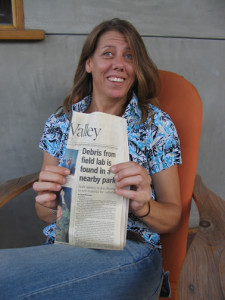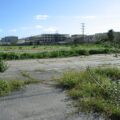
Earth movers and shakers would be an accurate description of Walsh and Bowling who caused a massive excavation on the northern border of the old Rocketdyne lab when they discovered toxic debris from past NASA operations including antimony and asbestos. Our “Cleaning Up Rocketdyne” article about this unprecedented excavation appeared in the November 21, 2007 edition of the Ventura County Reporter.
StopRunkledyne.com, the Radiation Rangers’ website, has Walsh’s 13 pages of “Comments on the Runkle Canyon Response Plan” including photographs and maps. This well-crafted document clearly illustrates Walsh’s concerns about the canyon. Her expertise and ability to crunch numbers, analyze data, and conceptualize how it all stacks up in the grand scheme of things are remarkable.
Walsh first questions the interpretation of the strontium-90 data found in Runkle Canyon by the developer’s lab Dade Moeller & Associates:
While we appreciate the need to potentially use data already generated to date, we feel it crucial to point out that independent review of that data should include a detailed explanation for the contradiction between the summary of the data, and the data itself (i.e. strontium-90 exceedences). This goes further than to merely underestimate the results, they in fact, describe exceedences to the strontium-90 results as being within range that they define. Six of the seventeen original samples submitted exceeded the MDA in concentrations that ranged from 4.756 pCi/g in SS-6 to 0.686 pCi/g in SS-16.
The Dade-Moeller report summarizes these same results to mean that no exceedences occurred. There have been many concerns about the independence and quality of the analysis of this contractor. This “inaccuracy” constitutes a material misrepresentation of fact, through omission and unsupported conclusions, which make trusting the conclusions of these reports, impossible. These questions remain unaddressed and we feel they are primary to the task of determining the trustworthiness and accuracy of the data collected and analyzed to date so that a truly informed and protective decision can be made on the Runkle Canyon project.
Frustration over the use of inaccurate maps of Runkle Canyon relative to its proximity to the lab are voiced:
One of the greatest concerns we have about this project is the proximity to the Field Lab and the fact that these maps continue to be used, shows a blatant attitude of misdirection. This issue has been brought to the attention of the regulator (CalEPA Department of Toxic Substance Control), and the developer, as well as the recent Simi Valley Acorn and Ventura County Star, but clear-retraction is the responsibility of the developer, and needs to occur within this current evaluation and be done prominently in each of the newspapers who have been writing on the subject, and all project materials distributed need to be replaced with accurate factual information that includes a prominent map that shows the border.
Local residents participate in public hearings about land-use and proposed development, ENTIRELY on the basis of proximity to their lives. To mis-state the location and proximity of these hazards is to blatantly falsify the impacts of this project, and must therefore be corrected with equal muster.
It is important that the regulator and the developer understand the basis for the community’s concerns: The environmental hazard findings coincide with the community’s concerns over the proximity of Runkle Canyon, LLC., to the Santa Susana Field Laboratory. If the basis for concern is distance, and the developer publishes a map (including to the press) that falsely creates a buffer-zone of land to “allay fears of proximity,” that does not really exist, that is then a fraudulent representation of this project and its’ potential impact to the neighboring residents as well as the future residents planned within the project.
On Runkle Canyon’s groundwater, Walsh begins first by quoting Dade Moeller’s report which dismisses Rocketdyne as the chemical culprit in the canyon:
“Conclusions and Recommendations”: The Rocketdyne facility located to the east of the southern 715 acre parcel is reportedly the origin of groundwater plumes of degraded groundwater, containing perchlorate and TCE, that have migrated offsite to the east and southeast of the Runkle Site. Based on the reported magnitude and direction of degraded groundwater originating from the Rocketdyne facility and the results of soil, surface water, and groundwater samples collected from within Runkle Canyon it does not appear that the historic sources originating from the Rocketdyne facility are adversely affecting the Runkle property. Further evaluation of chemicals of concern potentially originating from the Rocketdyne facility appears unwarranted at this time.” (P. 21/150)
This conclusion is questionable. TCE, which has a plume of subsurface contamination in Area IV above the 11-acre drainage into Runkle Canyon, has been detected in Runkle Canyon groundwater. Perchlorate has been detected in the site’s groundwater at levels ranging up to 55 times the Public Health Goal. The surface water has been impacted by high levels of arsenic, chromium, nickel, vanadium, barium, cadmium and lead. The surface soil has high levels of some of these heavy metals as well as strontium-90.
This Geocon report says it examined other reports to help form the conclusion that these substances aren’t coming from Rocketdyne and don’t need to be further evaluated. In the May 8, 2003 Miller Brooks Phase I & II report performed for GreenPark Runkle, it says regarding perchlorate: “The source is thought to be the SSFL facility.” Please remember that we do not have any evidence to demonstrate another possible source up in the canyon, and the fact that Simi Valley stopped looking, is not the same as finding evidence to the contrary. What we have here is evidence of perchlorate at Runkle Canyon and an operational facility that used perchlorate just above the site.
Walsh on groundwater-monitoring and offsite migration of radionuclides, chemicals and heavy metals possibly from the massive lab uphill of Runkle Canyon:
Runkle Canyon should be monitored for the foreseeable future due to the high levels of perchlorate previously found, and the verified presence of TCE, NDMA and other potential contaminants of concern. We hereby request that continued monitoring be done to determine the impacts to the groundwater, until proper and complete characterization of the groundwater at the SSFL is completed.
“Analytical results of surface water samples collected from East and West seeps in Fishtail Area that are not produced in a report. Samples were collected by Miller Brooks on April 5, 2005.” This idea of selectively picking and choosing the results to report on, creates an unacceptable level of bias to downplay the contaminant findings and suggest that “less looking” is appropriate. (P. 5/150)
Inaccurate claims of groundwater pumping are made here, when the pumping according to Boeing’s own statements, was turned off in 2000. “Historic pumping depressions at Rocketdyne have limited the movement of degraded groundwater beneath the property and have essentially confined the extent of known groundwater contamination to the area beneath the facility. Offsite migration of degraded groundwater has been identified in isolated areas along the northwest and eastern property boundaries.” (7/150) This brief, and insufficient statement of conditions of the groundwater work at SSFL, is inappropriate here as it leaves the impression that the groundwater issues at the SSFL are resolved, which clearly, they are not. There are many plumes at the site and the primary work done on groundwater characterization has been to support their own assumptions, which are based on not finding these COCs in other areas of the site and surrounding areas. The fact that they are present at the Runkle property directly contradicts the claim that it has only been found in these “well-defined areas.”
Even with yesterday’s Coup de Goo, it remains to be seen if these comprehensive and cogent comments by Christina Walsh will be given an accurate accounting. They are so clear, however, that it seems that Walsh has taken much of the work out of analyzing this information herself. Taking these and other comments seriously could save more than just a pretty penny for the Department of Toxic Substances Control.
Next “Railroading Runkle Canyon?” blog post: ACME Runkle Canyon Comments
24 Years of Award-Winning SSFL/Rocketdyne Reporting
June 1998 – June 2022












I would just like to add (I haven’t seen these comments for a long time, and we just came across data that claimed that the groundwater contamination seen at the Area IV burnpit extends out one mile.) One mile? One mile from the edge of the property by Runkle Canyon? Doesn’t that potentially put that contamination on Runkle Canyon land? I’ll talk to Bill [Bowling] today as he can ALWAYS put his finger on the document in question. Really relevant to what is happening right now, and really relevant to Runkle Canyon too.